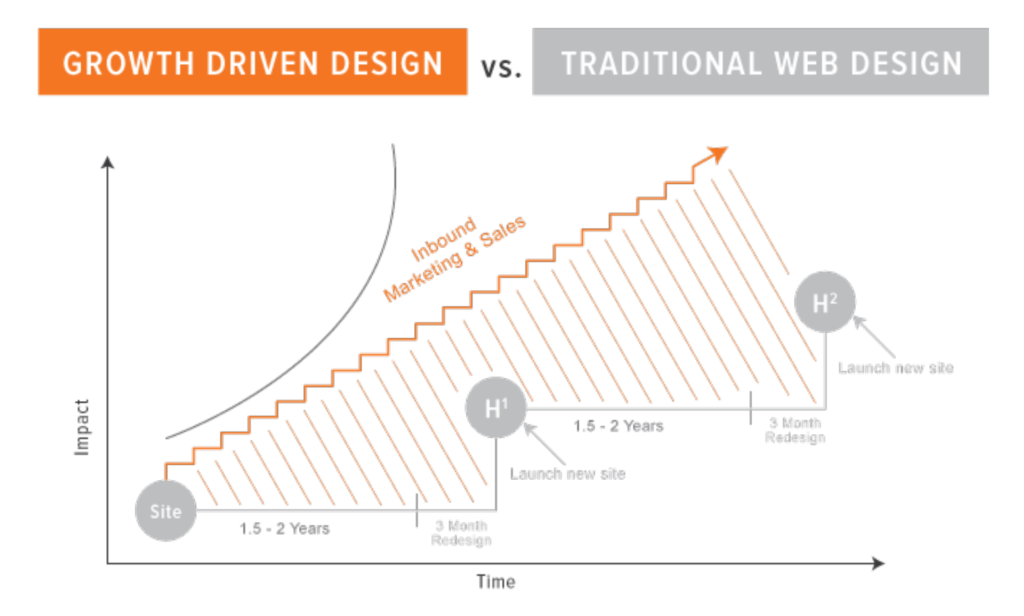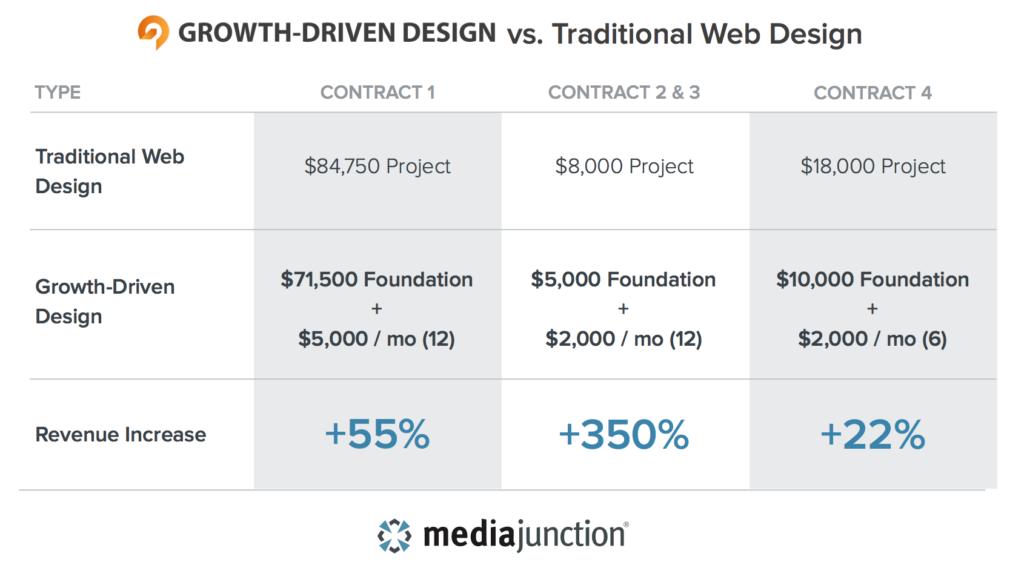Reaching the Pinnacle of Fast, Cheap & Good Website Building. (Well, Almost).
We’ve all seen the chart. There are countless versions, but I know you’ve come across something like it—the three-circled Venn diagram labeled “Fast,” “Cheap,” and “Good.” In the middle, the three circles meet in a mountain of sarcasm: “You’re dreaming,” “Non-existent,” or a simple, “HA.”
The reason this diagram resonates with creatives is because, while we know it’s completely true, our clients never seem to get the memo. They always want our work fast, cheap and good—even when that’s technically impossible. But, what if I told you there may be a way to build your clients a higher-quality website in less time—and convince them to pay what it’s worth instead of cheaping out?
What is this magical unicorn method you speak of?
I recently completed a very insightful (and free!) course from Hubspot on Growth-Driven Design (GDD). If you aren’t a designer, don’t tune out yet. I’m not just talking about the visual design of a website. I’m talking about a method of website building that allows you to put out a new or updated website quickly, then continuously improve it in a manner that will drive better results for your client and more income for you.
What exactly is Growth-Driven Design?
GDD is an answer to all the risks of traditional web building. Usually, websites are built comprehensively and all at once. Hours, days and months are spent planning out the content, wireframing, prototyping and everything else that comes with building a website. Usually, the project will go out of scope, over budget and way past the deadline.
Usually, website projects go out of scope, over budget and way past the deadline.
By the time you get the website up and running, the content is relevant for a few more months before you need to start thinking about a refresh. Ultimately, there is no real strategy behind the content or design. With GDD, you’re still performing all those aforementioned tasks, but you’re doing it in a way that’s more strategic and ongoing than before.

How can I create a higher quality website with Growth-Driven Design?
Great question. In the first phase of GDD, you start building a strategy and formulating hypotheses that you will actually answer down the line. This is remarkably different from the traditional process because you’re not just setting and forgetting the site. But first, you must use the strategy phase to research how the website and its content will meet the needs of its users.
I won’t get into the nitty-gritty details of each GDD phase—you should ake the course for that—but basically, this first part of the process can be achieved by asking lots and lots of questions. Using surveys, interviews and other research tactics, you’ll want to start building personas, finding out your client’s goals, mapping out your buyer’s journey, and making fundamental assumptions.
Once you’ve completed all these exercises, you can use your findings to brainstorm a wish list of creative, game-changing ideas for your website. This wish list should include every section, page, feature, module, etc., that will drive value for your clients and their users. Most lists will contain 75 to 200 high-quality ideas, but don’t panic—you won’t be expected to fulfill them all right away.
How is Growth-Driven Design a faster way to build websites?
With GDD, you’re using an agile or SCRUM framework to push a “launch pad” site live in 30-45 days. The launch pad website is the focus of the second phase of GDD, and it’s critical to keeping the project on budget and on time.
Growth-Driven Design is an answer to all the risks of traditional web building.
Remember just a few sentences ago when I said you should end the strategy phase with 75 to 200 high-quality ideas to incorporate into the website? The launch pad site will likely contain only 20% of those ideas. To pick and choose the 20% that stays and the 80% that goes, you’ll need to take a look at all the wish list items and decide which will have the most impact once executed.
If your client already has an existing site, decide whether they need a full redesign or if you can make adjustments to their current structure. If a redesign is in order, using templates is a great way to shave time off of the process. You’ll also want to do an audit of all the existing content to see what can be salvaged, what needs to be reworked or removed, and where there are holes that need to be filled. Figure out what’s a priority for this cycle and what can wait. Make sure the content you decide to use or create for the launch pad site works within the strategy you’ve laid out in the first phase.
Decide up front which launch pad site ideas will need high-fidelity wireframes, prototyping, and user testing, and which can be produced without this extra legwork. If you’re working with a team, be sure to meet often so that you can check the status of each idea. If you’re working alone, take a look at your list of items at the beginning of each day and see where you are in the process so that you can keep things on track and meet your 45-day goal.
How will Growth-Driven Design help me earn more money?
In the traditional web building process, you would likely charge one price for one site. You’d complete all the steps necessary to build the site, then get paid. With GDD, your process (and billing period) continues past the launch of that initial site.
That’s because at the end of the launch pad phase, you should have a fully functioning website that is more appealing and performs better than what the client previously had; however, this site is not the final product. You can now begin collecting user data and feedback to improve the site continuously and provide more value for your clients and their users.
This third phase is called “continuous improvement” and it involves two important components. The first is the Growth-Driven Design hierarchy. This is a ladder of factors that contribute to the success of your website:
- Audience: Does the website have a constant and predictable of organic visitors?
- Value: Are visitors finding value in what is posted on the site?
- Usability: Can users intuitively find value as quickly as possible, complete the tasks they intended on finishing and leave the site feeling happy and satisfied?
- Conversation rate optimization: Is there reduced friction to maximize the number of users who complete the whole funnel from start to finish?
- Stickiness: Are visitors coming back?
- Personalization: Where possible, is the site broken apart or made unique to different user types to meet their specific needs?
- Assets: Does the site offer items of high value to users for free?
- Promoters: Are people telling their friends, family and colleagues about the site?
It’s important to ask yourself these questions—in order—and identify problem areas. Once you’ve pinpointed what you can improve on your client’s site, you’ll want to use the second component of this phase—the continuous improvement cycle.
During this cycle, you’ll:
- Plan: Use research methods to find out why you’re having problems in that area of the hierarchy and build a plan to improve
- Build: Implement the high impact items and set up experiments to test your hypothesis, then launch your improvements to begin collecting data
- Learn: Review the results, find out what you learned, and share the findings
- Transfer: Your team will collaborate to create recommendations, share user learnings and ask questions
These four steps should be repeated for each area of the hierarchy in which your client’s website is underperforming. Not only does this improve the quality of the content for the client, but it also provides an additional stream of income for you by increasing the size of the engagement for new and current clients.
How do I price out Growth-Driven Design?
When you figure out the right formula for packaging and pricing GDD services, you can make your revenue more predictable. And while there’s no cookie-cutter template for invoicing clients who sign up for GDD, there are a few guidelines you can follow as you figure out your pricing.
First, let’s focus on the strategy portion of the GDD methodology. This phase should never be skipped; therefore, you should always include this in your retainer package. Some find it easiest to create low-, high-, and medium-strategy budgets to use as starting points for each client engagement. To define these budgets, look at all of the items needed to put together an amazing strategy. Include those items in your high-strategy budget, then take away some of the less crucial items to create a medium-strategy budget. Pare down your list even more until only the essentials are left to create your low-strategy budget. Consider the hours and levels of expertise to complete each of these items to determine the value of each strategy budget.
Some find it easiest to create low, high, and medium-strategy budgets to use as starting points for each client engagement.
To price out the second phase, audit the client’s existing site, look at the proposed number of pages to be included in the launch pad site and determine the impact of each one. Since high-impact pages will likely require prototyping, user testing and other process steps, they should cost more than low- and medium-impact pages. Consider the hours and levels of expertise to complete the steps needed at each level of impact, then create a base rate for each level. Multiply the number of pages within each impact category by their respective rate and add the totals together to determine a base cost and hours needed. Generally, it’s a good idea to pad these hours by 5-8% and roll any unused time into the continuous improvement phase. You can also give a ballpark range that is contingent and adjustable based on the strategy phase findings.
Finally, you’ll want to budget for a minimum of 20 hours for the continuous improvement phase. As it relates to the continuous improvement cycle, this breaks down into four hours for planning, ten hours for building, three hours for learning, and three hours for transferring; however, the average time needed for continuous improvement is more like 35-65 hours per month. This number depends on how fast you’re expected to complete work for the client. The more hours you spend each month, the more you’ll get done.
The amount you charge per hour will vary based on you and your team’s years of experience and level of expertise, but the industry standard is roughly $100 per hour. For the most part, however, you’ll want to avoid discussing your rates with the clients in terms of hours. Instead, focus on the output. This will give you the flexibility to use subcontractors or coordinate with any team members that you pull into the project. Some GDD methodologists even use a point-based system that assigns point levels to all common activities. These point values are determined based off of hours to complete each task, the complexity of the task, whether you need outside vendors to complete the task, and other similar factors. Clients can then buy a certain number of points each month to “spend” on action items.
How do I sell Growth-Driven Design to my clients?
You don’t need to wait until you have a new client to try GDD. For starters, you can try out the methodology on your own website. After you get your feet wet, try upselling to a current client. To do this, it’s critical that you don’t just pitch the GDD methodology cold. Clients need to understand the importance of their website and the value it should bring to their customers. According to Hubspot’s Luke Summerfield, they should walk away from their meeting with you knowing that their website is their main marketing asset.
For many clients, their pain points are similar: The website launched late, it went over budget, or it was very expensive for one site.
When selling to both current and potential clients, consider turning what might have once been a sales pitch into a working meeting. Ask your client to identify how their customers primarily hear about their company, how they find information about the company or product, where the website currently fits into the sales process, and other crucial information that could give you insights into what they hope to achieve with their website. If you don’t already know, you should also find out what their pain points and successes have been when using the traditional web building process. Use this information to show them how bringing you on through a GDD retainer will help them reach their goals while enhancing their successes and eliminating the pain points they identified.
For many clients, their pain points are similar: The website launched late, it went over budget, it was very expensive for one website, or it distracted resources from other important initiatives. With GDD, you can combat these objections immediately because the process is quick, the cost is spread out over time, and the results are based off of data so that the site is continuously improved.
In the chart below, you can see how the revenue compares to traditional web design. Even if you charge less after the first contract to continue chipping away at the other 80% of your initial idea list, you’ll still experience an increase in revenue. Meanwhile, the client is getting much more value out of their website. Ultimately, everyone wins with GDD.

Anything else I should know?
SO MANY THINGS. But I can’t possibly cover all of them in this one itty bitty post! To take a deeper dive into the Growth Driven Design methodology and learn more about how to sell it to clients, be sure to take Hubspot’s free course. Be forewarned—it’s a 13+ hour class, but it will absolutely change the way you approach your next website build and help you reach the pinnacle of fast, good and valuable.
This work is licensed under a Creative Commons Attribution-ShareAlike 4.0 International License.


